What is the Henneke horse body condition scoring system?
Devised by Dr. Henneke from Texas A&M University back in the early 1980s, the scoring system is the now used the world over to measure a horse’s condition. It measures certain areas along the horse’s body to get an overall score that gives the horse’s condition. The official characteristics of the scoring from Dr. Henneke’s paper are:
1 – Poor
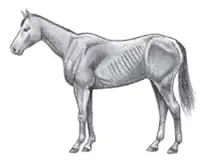
- Neck – Bone structure easily noticeable, animal extremely emaciated, no fatty tissue can be felt.
- Withers – Bone structure easily noticeable.
- Loin – Spinous processes project prominently.
- Tailhead – Spinous processes project prominently.
- Ribs – Tailhead (pinbone) and hook bones project prominently.
- Shoulder – Bone structure easily noticeable.
2 – Very Thin
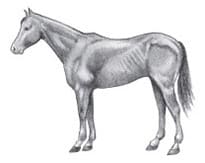
- Neck – Faintly discernible, animal emaciated.
- Withers – Faintly discernible.
- Loin – Slight fat covering over base of spinous processes. Transverse processes of lumbar vertebrae feel rounded. Spinous processes are prominent.
- Tailhead – Tailhead prominent.
- Ribs – Slight fat cover over ribs. Ribs easily discernible.
- Shoulder – Shoulder accentuated.
3 – Thin
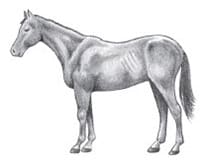
- Neck – Neck accentuated.
- Withers – Withers accentuated.
- Loin – Fat buildup halfway on spinous processes but easily discernable. Transverse processes cannot be felt.
- Tailhead – Tailhead prominent but individual vertebrae cannot be visually identified. Hook bones appear rounded but are still easily discernable. Pin bones not distinguishable.
- Ribs – Slight fat cover over ribs. Ribs easily discernible.
- Shoulder – Shoulder accentuated.
4 – Moderately Thin
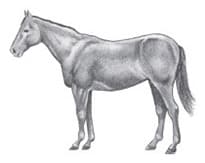
- Neck – Neck not obviously thin.
- Withers – Withers not obviously thin.
- Loin – Negative crease along the back.
- Tailhead – Prominence depends on conformation; fat can be felt. Hook bones not discernable.
- Ribs – Faint outline discernable.
- Shoulder – Shoulder not obviously thin.
5 – Moderate
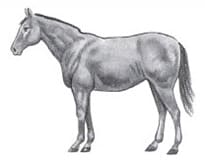
- Neck – Neck blends smoothly into the body.
- Withers – Withers rounded over spinous processes.
- Loin – Back level.
- Tailhead – Fat around tailhead beginning to feel spongy.
- Ribs – Ribs cannot be visually distinguished but can be easily felt.
- Shoulder – Shoulder blends smoothly into the body.
6 – Moderate Fleshy
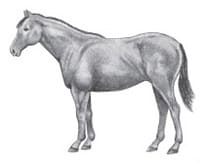
- Neck – Fat beginning to be deposited.
- Withers – Fat beginning to be deposited.
- Loin – May have a slight positive crease down back.
- Tailhead – Fat around tailhead feels soft.
- Ribs – Fat around tailhead feels soft.
- Shoulder – Fat beginning to be deposited.
7 – Fleshy
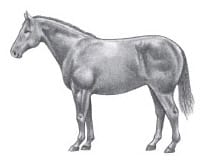
- Neck – Fat deposited along the neck.
- Withers – Fat deposited along the neck.
- Loin – May have a positive crease down back.
- Tailhead – Fat around tailhead is soft.
- Ribs – Individual ribs can be felt, but noticeable filling between ribs with fat.
- Shoulder – Fat deposited behind the shoulder.
8 – Fat
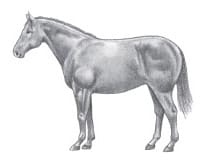
- Neck – Noticeable thickening of the neck, fat deposited along inner buttocks.
- Withers – Area along withers filled with fat.
- Loin – Positive crease down back.
- Tailhead – Tailhead fat very soft.
- Ribs – Difficult to feel ribs.
- Shoulder – Area behind shoulder filled in flush with the body.
9 – Extremely Fat

- Neck – Bulging fat. Fat along inner buttocks may rub together. Flank filled in flush.
- Withers – Bulging fat.
- Loin – Obvious positive crease down back.
- Tailhead – Building fat around tailhead.
- Ribs – Patchy fat appearing over ribs.
- Shoulder – Bulging fat.
From Henneke et al. Equine Vet J. (1983) 15 (4), 371-2.
Common mistakes
There are a few common mistakes that people make when checking a horse’s vital signs but luckily they’re all pretty easy to avoid.
- Make sure you follow the guidelines for how long to leave the thermometer in for, if you don’t you’ll end up with a false reading.
- If the horse is nervous you’ll get higher than normal TPR readings, instead wait until he’s more relaxed.
- If you don’t check your horse’s vital signs regularly you won’t know what’s normal for him. You don’t need to check them every day, once a month is fine.
- Make sure you count your horse’s heartbeat properly. The heart will make a ‘lub-dub’ sound, this is one beat so make sure you don’t count it was two.
- If you don’t have a watch make sure you count the seconds properly, it’s easy to count a few seconds for everyone. Try adding a bumblebee to every second, for example, one bumblebee, two bumblebees, three bumblebees, etc. It might sound silly but it helps you to count the seconds properly.
Page 1 – Your horse’s vital signs
I hope you found this article helpful. If you did I’d be grateful if you could share it please as it would really help me.
Recommended products
Over the years I have tried hundreds of different horsey products, from various blankets and halters to different treats. Some I’ve loved, others I’ve hated but I thought I’d share with you my top all-time favorite products, the ones I never leave the yard without. I’ve included links to the products (which are in no particular order) that I really think are great.
- Horse Knots by Reference Ready – If you’re like me and enjoy pocket reference guides then you’ll love this knot tying guide. These handy cards can easily fit in your pocket or attach to the saddle for quick reference. They’re waterproof, durable and are color coded to make them easy to follow.
- Mane ’n Tail Detangler – Even if you never show your horse you’ll need to detangle his tail from time to time (and possibly his mane too) which is always a challenging chore! I’ve found that if I run a little bit of detangler through my horse’s tails every few days it stops them from getting matted up and makes combing them easy, even if they’re coated in mud. I don’t know if I should admit to this or not but it also works wonders on my hair.
- TAKEKIT Pro clippers – Over the years I’ve tried a lot of different clippers and while some were obviously better than others I found these to be by far the best. They are heavier than a lot of other clippers but for me, that’s a good thing, it makes them feel more sturdy and hardwearing. On top of that they have a range of speeds so are just as good for clipping your horse’s back as they are his face. I also like the fact that they come in a handy carry case but that’s not for everybody. The company that makes them is super good and incredibly helpful too, a real bonus these days. The only thing I wasn’t keen on was the fact that it doesn’t come with any oil, but that’s not a major problem as it’s not difficult to buy lubricant.
- Shire’s ball feeder – There are so many boredom buster toys out there but I like to use these every day, regardless of whether or not my horses are bored. I find that it helps to encourage my horses to problem solve by rewarding them with treats (or pieces of fruit) but it also mimics their natural grazing behavior which helps to keep them calm and de-stressed.
- Horse safe mirror – This is a strange one that many people are surprised about but I like to put horse safe mirrors in the trailers as well as in the quarantine stalls. It helps to prevent the feeling of isolation by giving the impression of other horses being around. Being herd animals horses can get extremely stressed when they feel that they’re on their own but with these stick-on mirrors, they believe that at least one other horse is with them.
- Rectal thermometer – I know this isn’t glamourous at all but it’s vital for your horse’s well-being to be able to check their temperature and a rectal thermometer is the easiest way of doing this which is why I’ve added it to the list.
Shopping lists
I’ve also put together a few shopping lists of essential items that I’ve found helpful over the years. I’ve broken the lists down into different categories rather than put everything in one massive list 😉
